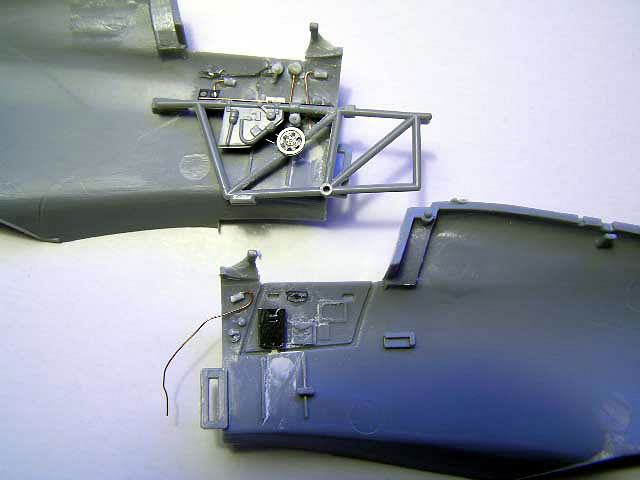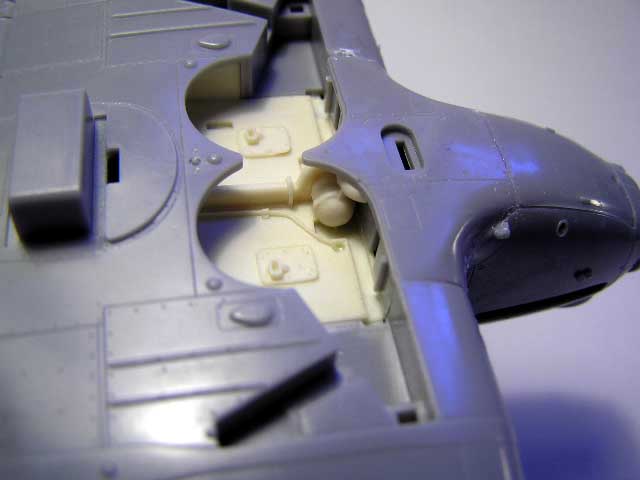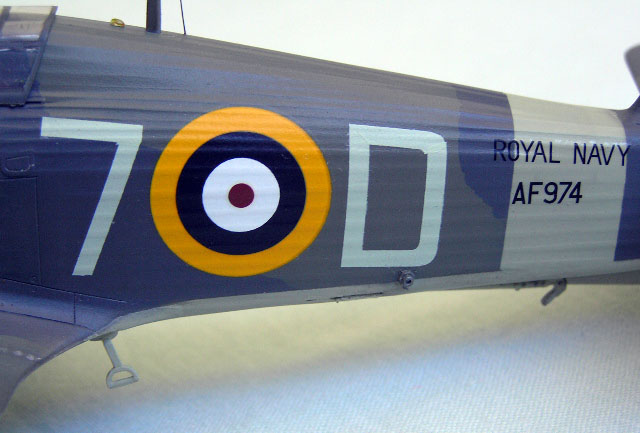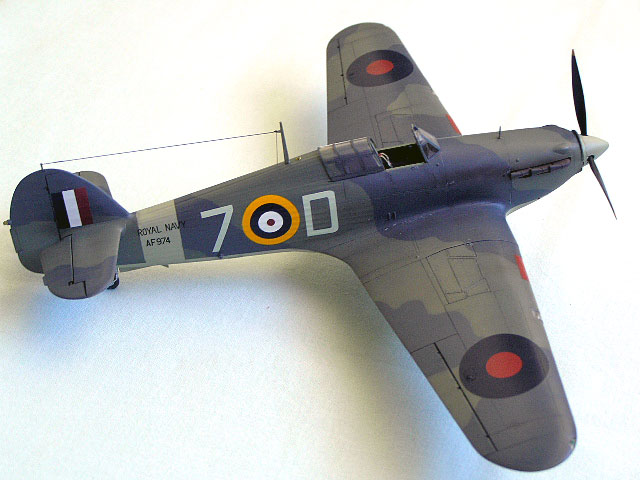|
Hasegawa +
MDC
1/48 scale
Hawker Sea Hurricane Ib
by Fernando Rolandelli
|
 |
|
Hawker Sea Hurricane Mk
Ib
AF974 “7D”, 880 Sqn., Fleet Air Arm, HMS Indomitable, Indian
Ocean, 1942 |

Hasegawa's 1/48
scale Hurricane Mk.I is available online from Squadron
Background
In early WWII, the Admiralty half heartedly recognized that
carrier-borne aircraft should be at least capable of facing their
land-based counterparts. Moreover, fighters specifically did not
necessarily need to be big two-seaters. While the two fighters already
on development were (the Fairey Fulmar and later the Firefly), trials
were made with RAF single-seaters. The first to become navalized was the
Hurricane, in various hybrid forms, like the Mk I “Hurricat”, first, and
then a true naval fighter version, the Mk Ib, albeit still lacking
wingfold.
HMS Indomitable, the only Illustrious class whose lifts could
accommodate a Sea Hurri, took part, after the “Force Z” disaster, in the
reinforcing of Ceylan first, and the taking of Vichy French Madagascar
later (Operation Ironclad). In this operation, it embarked the Sea
Hurris from 880 Sqn, FAA. CAP was left to 881 and 882 Sqn Martlet Is and
IIs off HMS Illustrious, but Sea Hurris from 880 Sqn. took part in the
sinking (by machine-gun fire alone!) of the armed sloop D’Entrecasteux.
Only nine machines were available, so there is a high possibility that
AF974 took actually part in the attack. After this operation, HMS
Indomitable returned to the Mediterranean to take part in the better
known “Operation Pedestal”, the big relief of Malta in August, 1942,
with virtually the same aircraft complement. Most pictures of 880 Sqn.
Sea Hurris come from this operation, but one of the best known ones does
not show the Yellow leading edge tactical markings adopted during
Pedestal, so there is a strong chance that it was actually taken during
Ironclad.
The Kit
This is the well known 1/48 scale Hasegawa model, in its “Nº 09494
Night Fighter” incarnation. I wanted to keep the FAA theme as well as
the Far East theme, so I settled down for AF974.
The decals came originally form the SkyModels 48-052 “Hawker
Hurricane Pt.2” sheet. I also used the Ultracast resin wheel well,
Eduard 48-301 “Hurricane Mk I” PE set, and Model Design Construction set
CV0016, “Sea Hurricane MkIIc” conversion set.
In the end I also resorted to the Eagle Decals “Early Spitifire and
Hurricane Roundels” and to Xtradecals X023-48 “Squadron Code Letters and
Numbers, 24” and 30”, Sky”.
Of course, the heart of the project was the conversion. The MDC set is
most complete and well moulded. However, after cutting (seemingly
accurately) the fuselage I found that a gap had been created. I decided
that the problem could be addressed by adding some plastic to the
tailwheel well, and it worked indeed. Once I had made the conversion to
my satisfaction, I laboriously built the cockpit using the Eduard set
and some scratchbuilding.

Then I very cautiously added the nose, glued in the front and left
more or less open at the back, so I could maneuver it into the fuselage,
minimizing the gaps successfully. I also corrected the “step” in the
pilot’s headrest, widening it with layers of Parsecs epoxy. The head
armor should cover the entire surface, but modifying this would be a
chore, and I left it as it is. Following some of my references, I sanded
off the oil ring collector, but looking at some pictures I realized I
shouldn’t have done so. I restored it with a plastic sheet, which looks
more scale-wide in the end.

Installing the resin wheels well was also a chore, aggravated by my
forgetting about painting its back Interior Gray-Green. Wing
construction proceeded rather smoothly; the Eduard set allows you to
lower the flaps, but the structure looks very daunting and pictures of
parked Hurris in such a configuration are rare. The gun inserts were
faired after long sessions of sanding; I had feared that the wing’s
surface had been “flattened”, but the effect is hardly noticeable. The
wingtip position lights are also troublesome, being much thinner that
the sockets. I found no better solution to this than restricting the
step to the undersides and filling and sanding as best as I could.

I had planned to mimic the Red tape over the gun muzzles just by
painting, but some preparations should be made at this stage. I first
filled the gun troughs with White Glue, hoping that they would remain
barely visible. The effect, however, was too stark and I resorted to
putty. I still managed to conserve a hint of the gun troughs, however.
If you want a completely smooth effect, using the “IID” inserts, which
show only one gun trough, may be a good idea.
Hurricane I’s propeller and spinner combinations are some sort of a
conundrum. I suddenly realized that my kit did not have the one I
needed! I quickly ordered another kit, Nº 09562 “Croix de Lorraine”,
which can be finished as either a Mk I or a Mk IIb, and comes with all
the “prop’n’spinner” combos issued in Hase’s kits. Therefore, I raided
the kit for the De Havilland prop and “small” spinner.
With everything adequately glued, puttied, sanded and polished, the
model went to the paint shop.
Paint
 The
interior was painted British Interior Gray-Green from the Polly S range;
no surprises here. The wheels well was painted Silver, using WEMM’s
“Alluminio” FS 27178, together with the interior face of the u/c doors
and the struts. The
interior was painted British Interior Gray-Green from the Polly S range;
no surprises here. The wheels well was painted Silver, using WEMM’s
“Alluminio” FS 27178, together with the interior face of the u/c doors
and the struts.
The camouflage is the standard FAA Pattern nº 1, “B” Scheme, in DSG/EDSG/Sky.
The DSG is the famous Xtracolor one; the other two are WEMM’s. They were
painted over a Light Grey primer preshaded (yes… preshaded!) in Raw
Umber. The Sky was applied unevenly, and made even more so by means of
further applications of the same colour somewhat darkened. Then, the
uppers were painted in EDSG, again in uneven fashion. I masked this with
Maskol, and in went the DSG, following suit. The Sky band was masked at
the beginning. The result, specially the DSG on the darker EDSG, is
interesting to the view.
The red tape was painted next.
Weathering was performed mainly by oil washes and some postshade in a
dark glaze. Exhaust fumes were mimicked by airbrushing Light Gray and
Burnt Umber. Minimum paint chipping was achieved with a silver pencil.
Decals
Though I did not use the kit’s decals, I am happy to report that they
seem good: the White is not entirely White, but at least not entirely
Ivory either! Regarding the scheme it seems dead on, though the “Combat
Colours” book shows it in a profile with a Dark Blue spinner and flash
(they are Red in the decals). Also, a picture in Osprey book confirms
the use of six-stack exhausts (the former reference show standard
fishtails) The decal for the flash seems daunting enough to make you
seriously consider painting it, so in fact you can choose the colour you
deem most plausible.

I prepared the surface with many coats of Testor's Glosscote, then I
started to cut the SkyModels decals. Again, problems arouse. Roundels in
the Sky Models sheet have less than perfect colours, specially the
underside “A type”, whose center is undoubtedly in Bright Red. So I
resorted to the Eagle Decals ones… but the “Type As”, in theory 50”,
were a tad bigger. The Sky Models codes, which should be in Sky, are
darker and greener than the paint (conversely, those in Sea Gray Medium
are too light). The effect is noticeable and very ugly, to say the
least. Pity, for they are the right size. I used the 30” Xtradecals
codes, though the originals were 27”. Pictures of the left side show the
codes painted in a very odd fashion, as if using the stringers in the
fuselage as a guide. I cut the decals to follow suit. I have not seen a
picture or the other side, but I guessed the same procedure would have
been applied. The decals withstood the cutting and abusing quite well.
In the end, only the serials used came from the Sky Models sheet, and
they also worked fine.
A nice project, not devoid of challenge, and involving the use of a
resin conversion set and generic decals.

In this way, you can model one of the handful of Sea Hurricanes to
see combat in the Far East, and this one even successfully!
-
“Combat Colours Number 2, the Hawker
Hurricane 1939 to 1945 in RAF, Commonwealth and FAA service”, HC
Bridgwater, Guideline Publications.
-
“The Hawker Hurricane”, Richard A
Franks, SAM Publications
-
“Britains’s Fleet Air Arm In World
War II”, Ron Mackay, Schiffer Military History Book
-
“Fleet Air Arm, British Carrier
Aviation 1939-1945”, Ron Mackay, Squadron Signal Publications
-
“British Naval Aviation. The Fleet
Air Arm, 1917-1990”, Ray Sturtivant, Naval Institute Press
Click
the thumbnails below to view larger images:
Modelling the P-40
Hawk 81, Tomahawk, Warhawk and Kittyhawk
Osprey Modelling 15 |
|
|
|
|
Author: Brett Green
US Price: $17.95
UK Price: £12.99
Publisher:
Osprey Publishing
Publish Date:
January 10, 2004
Details: 80 pages; ISBN: 1841768235 |
|
|
Text and Images Copyright ©
2006 by Fernando Rolandelli
Page Created 10 July, 2006
Last Updated
09 July, 2006
Back to
HyperScale Main Page |
Home
| What's New |
Features |
Gallery |
Reviews |
Reference |
Forum |
Search